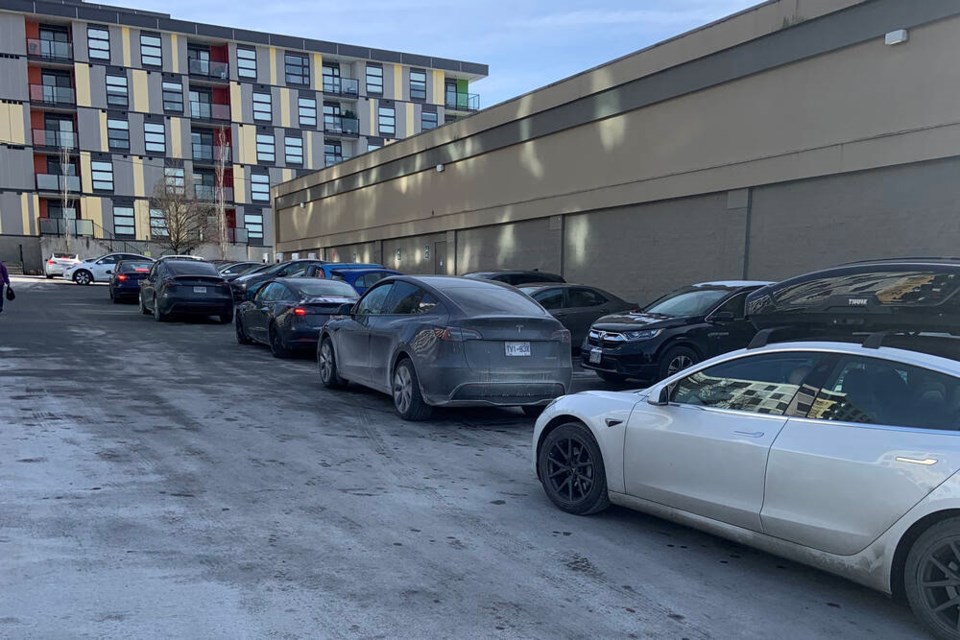Tesla’s lightning-fast superchargers are bringing traffic to a crawl at a retail parking lot in one of the busiest areas of North Vancouver.
On Saturday afternoon, a dozen Teslas could be seen lining up along the north side of the London Drugs parking lot in Central Lonsdale.
As Pat Johnson looked for a parking spot, he witnessed a cacophony of honking, finger pointing and parked cars trapped by the queue of electric vehicles. After a failed search, Johnson found that the lot was full and had to park on the street.
Tucked at the back corner of the parking lot are 12 superchargers, the only ones on the North Shore. The demand is high for these proprietary Tesla plugs because they re-juice batteries at a much faster rate than other chargers. The London Drugs parking lot also hosts four J-1772 plugs, which are free to use but charge much slower.
Johnson says the present setup – having the supercharger location in a busy retail parking lot – is a disaster.
“I just I don’t see the rationale for having it where it is,” he said. “It’s time to have their own little Chevron Tesla station, away from people that are just trying to get on with their day.”
While the cold weather slows the charging process and cranking the heat in electric vehicles drains batteries faster, there are a host of other Tesla-specific complications that are causing congestion at the North Shore supercharger location, explains EV expert Bruce Stout.
Why are Teslas jamming up supercharger stations?
First to blame is Tesla’s own success. Over the past five years, sales of Elon Musk-mobiles have skyrocketed in B.C., rising to 45,589 in 2022 from 5,034 in 2018 – a gain of more than 800 per cent, according to data from ICBC. Those figures eclipse all other makers of electric vehicles.
The North Shore is home to eight per cent of the province's total Tesla population. Locally, the number of these EVs increased to 3,488 in 2022, up from 697 in 2018. Following the same trend, that number could have grown by another 1,000 vehicles in 2023.
After eight superchargers were installed at London Drugs in 2021, they were full almost immediately, said Stout, treasurer of the Vancouver Electric Vehicle Association. That’s why the other plugs were added soon after, he said.
“The deliveries of Tesla vehicles have increased dramatically because Tesla has been able to deliver vehicles,” Stout said. Meanwhile, other manufacturers have wait-lists that are months or years long.
“What’s basically happened is people have pivoted. Like, ‘I want to buy an electric car, and I want to buy it now. And I don’t want to wait for it.’ So they’ve gone and bought a Tesla,” he said.
Having the option of charging at home is ideal, Stout said, but many Tesla owners live in buildings without EV plugs.
“Up until recently, the strata councils have been blocking installation of charging at any of their buildings,” he said. “These are people that I call charging orphans – they don’t have a place to charge, so that’s why they’re all going to the supercharger at lunch.”
Part of the problem is user error, Stout added. Teslas come equipped with an app that tells drivers where supercharger locations are, how many plugs are available and will even start priming batteries for more efficient charging. But many drivers don’t take advantage of that technology.
Use the onboard app and avoid peak times, expert recommends
If a driver selects a charger as their destination, “it’ll also send a message internally to the car to start warming up the battery,” he said. “You’re going to charge faster, so you won’t take as much time there.”
“It’s an education thing,” Stout said, adding that drivers are charged by the minute at superchargers.
While it may be inconvenient to non-Tesla drivers like Johnson, hosting superchargers is appealing to businesses.
“Tesla puts in the superchargers, Tesla takes care of the maintenance,” Stout said.
Oftentimes when he’s charging up, he’ll walk into the store and end up buying something. “It’s brilliant marketing,” he said.
When asked about the congestion at the North Vancouver store, a spokesperson from London Drugs said that non-electric vehicles are allowed to park in the supercharger spaces, as per the agreement with Tesla.
"Diamond Parking is responsible for managing any reports of abuse of the parking lot," the spokesperson said.
Tesla was asked if it was aware of congestion issues at the London Drugs location, and about rumours of another set of supercharger plugs coming to the area, but the company did not respond by publication time.
"Tesla we love you, but we need at least 2 more supercharger locations on the North Shore," wrote one user on PlugShare, an app that maps out charging locations.
To avoid getting stuck in a jam, Stout recommends that Tesla drivers avoid peak times, acquaint themselves with the onboard app and employ good judgment.
“What’s your time worth?” he said. “If you can drive 20 minutes and swing into one of these superchargers like the one that’s in Brentwood [in Burnaby] – there’s nice restaurants and stuff there.”
“Just swing into Brentwood, you get 40 chargers you can use. It’s all education.”



